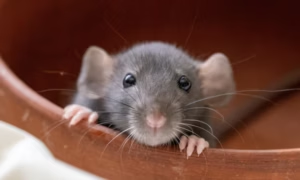 My Colorado grandkids and I stood in the “rodent room” at a local pet store. Six of us were crowded into the small space: a young man who worked there, a couple that looked to be in their early twenties, Josephine (age nine), Oliver (age six) and me.
My Colorado grandkids and I stood in the “rodent room” at a local pet store. Six of us were crowded into the small space: a young man who worked there, a couple that looked to be in their early twenties, Josephine (age nine), Oliver (age six) and me.
The employee was holding a small cardboard box. He opened the lid of the cage that held the youngest mice and turned to Oliver. “Hey, buddy,” he said. “I’ve got a customer out front. Want to pick out a mouse for him?” A dozen or so little mice scampered around in the glass enclosure. Black mice. Brown mice. Gray mice. Mice with spots. Mice whose ears were the same color as their tails. Oliver studied them all. Some mice sat up on their hind legs, pink noses sniffing the air. Some pressed their front paws and whiskered faces against the glass as if to say PICK ME! Others paid us no mind at all.
Finally, Oliver pointed to a gray mouse with four white feet. “I like that one,” he said.
With that, the employee reached in, snatched the gray mouse up by the tail and popped it into the box. Then he latched the cage door. “Good choice,” he told Oliver. “Thanks.”
I lifted my eyebrows in a silent plea that he not provide details about why the customer out front might have come in to buy a mouse. The young man smiled and shrugged. “Every living creature has to eat,” he said softly. He left the room and the kids and the twenty-something couple continued to enjoy the antics of all those rats and mice.
Not me, though. There was too much to think about.
The sign on every cage included the word “feeder.” Did that mean all these rodents were destined to become snake food? I asked the question of the young woman, who by this time had plunged her left arm into the enclosure where the medium-sized rats lived and was laughing as they scampered up and down it.
“Oh no,” she said. “Some people buy them for pets.”
She went on to tell me that she once owned three large rats—she called them her “boys”—and that they were the most wonderful pets she’d ever had. “Rats are very smart and very social,” she assured me. “Unfortunately, their life span is only about two years.” All her rats had passed away, she said, but the pet store was happy to let her come in and play with theirs. “It makes me happy and it makes the rats happy,” she told me. “Nobody loses.”
But I was focused on how the hapless rodents purchased as food rather than pets meet their untimely end. I did some research when I got home and learned that reptile experts warn against feeding live prey to pet snakes. The prey suffers psychological stress as it frantically and futilely tries to escape the cage. And in its panic, it will sometimes bite and injure the snake.
That’s why pet snakes are almost always fed dead mice or rats. The rodents are humanely euthanized either with carbon dioxide or by cervical dislocation, a fancy term for a broken neck. Some are fed as “fresh kill” but most are freeze-dried and then thawed before going into the snake cage.
Having learned all this, I tried hard to turn my mind to more cheerful thoughts. I imagined the gray mouse with four white feet that Oliver had chosen living a long, happy life in safe warm cage. The little mouse has plenty of food and water and soft wood shavings to snuggle down into on cold winter nights. Maybe it even has an exercise wheel and a plastic ball with a bell inside to push around with its cute little pink nose
Yeah. That’s my story and I’m sticking to it.
(Jennie Ivey is a Cookeville writer. Her email is [email protected])